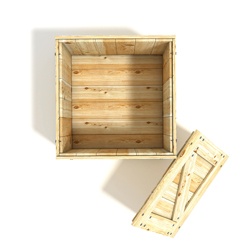
In February of 1964, the US Department of Agriculture, Forest Service published an extensive design manual for Wood Crates. The detailed publication sold for $.70 a copy, and was written by engineers at the University of Wisconsin's Forest Products Laboratory. The researchers identified that "the most important materials used in constructing crates are wood in its various forms and the fasteners used for fabrication and assembly. Sound crate design criteria and proper use of materials will result in a crate that combines maximum strength with minimum materials." Fifty-three years later, the more things change the more they stay the same.
Crating has become a preferred method for many types of products, especially as manufacturing has shifted to overseas locations, requiring the end-product to be shipped securely over treacherous seas and great distances. When designed and constructed properly, wood crates are extremely strong and able to protect their contents from damage, even under the most rugged conditions. They are also considered environmentally friendly for their reusability and their diminished reliance upon excessive packing material. All of these benefits that crating brings to the shipping industry are reliant upon the same two factors identified in 1964: the type of wood and the fastener used for construction and closure.
Much is written about overall crate design and crate types, focusing on the types of wood best suited for the conditions crates face and the expectations for their longevity. But when building the perfect crate, it's the smallest construction component, and often the least expensive, that can make or break the end-product: the fasteners. Without adequate fasteners, any design can suffer a critical failure.
In 1964, nails were the most common fastener used in wooden crating. When properly sized for the packaging needs, nails have the benefit of being applied quickly with a pneumatic nail gun to save labor costs, but require a crowbar be used to pry open the container upon arrival. This takes time and may damage the product inside, even though it has made it safely to its destination. The nails can cause damage to the wood on removal, and most likely cannot be re-used.
Screws have become more common in today's crating, as these removable fasteners allow easier and safer access to the product inside. This is particularly useful when the container must undergo a customs inspection when being shipped overseas. Screws also have dramatically higher holding power vs. nails, providing greater protection to the contents during transit. They are easy to adjust, and can be removed and reapplied, making the crate's reusability factor that much greater. However, using screws is a timely, more labor-intensive process, requiring manual insertion and removal.
A development the engineers of the 1964 article did not have the pleasure of experiencing during their research was the specialty hybrid fasteners becoming popular today, combining the holding power of a screw with the speed of a nail. One such product is the SCRAIL® fastener from The BECK Fastener Group, distributed by Fasco America®, which can be used wherever ordinary screws are used in the crating process, either as an assembly fastener or as a closure fastener. They provide the superior strength of a screw but are shot in by a pneumatic nail gun, so they won’t destroy the wood fibers during the application process. They can be applied twice as fast as collated screws and eight times faster than bulk screws, saving time in the closure process for manufacturers, and labor time and cost at the destination site, making SCRAIL® fasteners essential to the construction of the perfect crate.
.svg.png)

